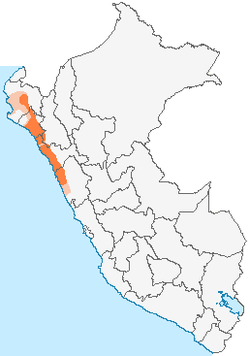Moche
|
|||||||||||||||||||||||||
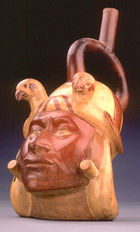
| History of Peru | |
|---|---|
 This article is part of a series |
|
| By chronology | |
| Ancient civilizations | |
| Inca Empire | |
| Spanish conquest | |
| Viceroyalty | |
| Independence | |
| Peru–Bolivian Confederation | |
| Guano era | |
| War of the Pacific | |
| Ecuadorian-Peruvian war | |
| Internal conflict | |
| By nation | |
| History of the Inca Empire | |
| History of the Viceroyalty of Peru | |
| History of the Republic of Peru | |
| By topic | |
| Demographic history | |
| Economic history | |
|
Peru Portal |
The Moche civilization (alternately, the Mochica culture, Early Chimu, Pre-Chimu, Proto-Chimu, etc.) flourished in northern Peru from about 100 C.E. to 800 C.E., during the Regional Development Epoch. While this is still the subject of some debate, many scholars contend that the Moche were not politically organized as a monolithic empire or state but rather as a group of autonomous polities that shared a common elite culture as seen in the rich iconography and monumental architecture that survive today. They are particularly noted for their elaborately painted ceramics, gold work, monumental constructions (huacas) and irrigation systems.[1] Moche history may be broadly divided into three periods – the emergence of the Moche culture in Early Moche (C.E. 100–300), its expansion and florescence during Middle Moche (C.E. 300–600), and the urban nucleation and subsequent collapse in Late Moche (C.E. 500–750).[2] Moche society was agriculturally based with a significant level of investment in the diversion of river water into a network of irrigation canals. Their culture was sophisticated and their artifacts document their lives with detailed scenes of hunting, fishing, fighting, sacrifice, sexual encounters and elaborate ceremonies.
The Moche cultural sphere is centered around several valleys on the north coast of Peru – Lambayeque, Jequetepeque, Chicama, Moche, Virú, Chao, Santa, and Nepena. The Huaca del Sol, a pyramidal adobe structure on the Rio Moche, had been the largest pre-Columbian structure in Peru; however, it was partly destroyed when Spanish Conquistadors mined its graves for gold. Fortunately the nearby Huaca de la Luna has remained largely intact – it contains many colorful murals with complex iconography and has been under excavation since the early 1990s. Other major Moche sites include Sipan, Pampa Grande, Loma Negra, Dos Cabezas, Pacatnamu, San Jose de Moro, the El Brujo complex, Mocollope, Cerro Mayal, Galindo, Huancaco, and Panamarca.
Contents |
Material culture
Moche pottery is some of the most varied in the world. The use of mold technology is evident which would have enabled the mass production of certain forms. But despite this, they had a large variation in shape and theme with most important social activities documented in pottery including war, sex, metal work, and weaving.
Traditional North coast Peruvian ceramic art uses a limited pallet relying primarily on red and white, fineline painting, fully modeled clay, veristic figures, and stirrup sprouts. Moche ceramics, created between 150-800 AD epitomize this style. These realistic pots were found not just at major North coast archeological sites like Huaca de la luna, Huaca del sol, and Sipan, but small villages and unknown burial sites as well.
Given the unusual emphasis on life-like depictions on the famous elite portrait vases, some have suggested that individuality was an important aspect of Moche political culture.
Because irrigation was the source of wealth and foundation of the empire, the Moche culture emphasized the importance of circulation and flow. Expanding upon this, the Moche focused on the passage of fluids, particularly life fluids through vulnerable and valuable human orifices in their artwork. There are countless images of defeated warriors loosing life fluids through their nose, or helpless victims getting their eyes torn out by birds or captors. Images of captive sex slaves with gaping orifices and leaking fluids portray extreme exposure, humiliation, and a loss of power.
The coloration of Moche pottery is often simple, with yellowish cream and rich red used almost exclusively on elite pieces, with white and black used in only a few pieces. Their adobe buildings have mostly been destroyed by looters and natural forces over the last 1300 years, but the huacas that remain show that the coloring of their murals was very vibrant.
The incredible detail in Moche ceramics could lend to the fact that they served as a sort of didactic model. Older generations could pass down general knowledge about reciprocity and incorporation to younger generations through these veristic portrayals. These sex pots could teach about procreation, sexual pleasure, cultural and social norms, a sort of immortality, and transfer of life and souls, transformation, and the relationship between the two cyclical views of nature and life.
Moche textiles were woven and made mostly from wool from vicuña and alpaca. Even though there are very few examples of this, the pure Moche people still have the knowledge of their ancestors and how they prepared their clothing.
|
Moche portrait vessel, Musée du Quai Branly, Paris |
 Resting Deer, Moche Culture, at the Larco Museum Collection |
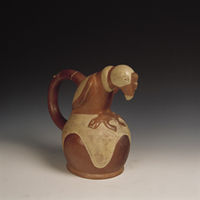 Condor, 300 A.D. Larco Museum Collection Lima, Peru. |
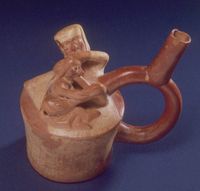 Moche ceramic depicting fellatio. 300 A.D. Larco Museum Collection |
Religion
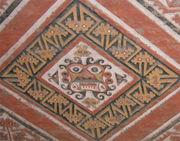
Both iconography and the finds of human skeletons in ritual contexts seems to indicate that human sacrifice played a significant part in Moche religious practices. These rites appear to have involved the elite as key actors in a spectacle of costumed participants, monumental settings and possibly the ritual consumption of blood. While some scholars, such as Christopher Donnan and Izumi Shimada, argue that the sacrificial victims were the losers of ritual battles among local elites, others, like John Verano and Richard Sutter, suggest that the sacrificial victims were warriors captured in territorial battles between the Moche and other nearby societies. Excavations in plazas near Moche huacas have found groups of people sacrificed together and skeletons of young men deliberately excarnated, perhaps for temple displays. The Moche may have also held and tortured the victims for several weeks before sacrificing them, with the intent of deliberately drawing blood. Verano believes that some parts of the victim may have been eaten as well in ritual cannibalism.[3] The sacrifices may have been associated with rites of ancestral renewal and agricultural fertility. Moche iconography features a figure scholars have nicknamed the 'Decapitator' or Ai Apaec; it is frequently depicted as a spider, but sometimes as a winged creature or a sea monster, all three features symbolizing land, water and air. When the body is included, it is usually shown with one arm holding a knife and another holding a severed head by the hair. The 'Decapitator' is thought to have figured prominently in the beliefs surrounding the practice of sacrifice.
Collapse
There are several theories as to what caused the demise of the Moche political structure. Some scholars have emphasised the role of environmental change. Studies of ice cores drilled from glaciers in the Andes reveal climatic events between 536 to 594 AD, possibly a super El Niño, that resulted in 30 years of intense rain and flooding followed by 30 years of drought, part of the aftermath of the climate changes of 535–536.[4] These weather events could have disrupted the Moche way of life and shattered their faith in their religion, which had promised stable weather through sacrifices.
However, it is clear that these events did not cause the final Moche demise. Recently discovered evidence suggests that the Moche polities survived beyond 650 AD in the Jequetepeque Valley and the Moche Valleys. For instance, in the Jequetepeque Valley, later settlements are characterized by fortifications and defensive works. While there is no evidence of a foreign invasion, as many scholars have suggested in the past (i.e. a Huari invasion), there is some evidence of social unrest, possibly the result of climatic changes as factions fought for control over scarce resources.[5]
Links with other cultures
Chronologically, the Moche was an Early Intermediate Period culture that was preceded by the Chavín horizon and succeeded by the Huari and Chimú. The Moche co-existed with the Ica-Nazca culture in the south and are thought to have had some limited contact with the Ica-Nazca because they mined guano for fertilizer in Ica-Nazca territory. Moche pottery has been found near Ica, but no Ica-Nazca pottery has been found in Moche territory. The coastal Moche culture also co-existed (or overlapped in time) with the slightly earlier Recuay culture in the highlands. Some Moche iconographic motifs can be traced to Recuay design elements.
21st century discoveries

In 2005, a mummified Moche woman was discovered at the Huaca Cao Viejo, part of the El Brujo archeological site on the outskirts of Trujillo, Peru. It is the best preserved Moche mummy found to date and the tomb that housed her had unprecedented elaborateness. The archaeologists on the site believe that the tomb had been undisturbed since approximately 450 AD. The tomb also contained various military and ornamental artifacts, including war clubs and spear throwers. A garroted young girl, probably a servant, was found in the tomb with her. News of the discovery was announced by Peruvian and U.S. archaeologists in collaboration with National Geographic in May, 2006.[6]
In 2006 perhaps the most lavish (certainly the most valuable, pound-for-pound) Moche artifact ever discovered turned up in a Londoner's office — a magnificent gold mask depicting a sea goddess with beautiful spirals radiating from her stone-inlaid face. It is thought that the artifact was looted from a nobleman's tomb in the late 1980s (La Mina); it has now been returned to Peru.[7]
See also
- El Señor de Sipán (the Lord of Sipán)
- Chimu Empire, heavily influenced inheritors of the Moche.
References
- ↑ Beck, Roger B.; Linda Black, Larry S. Krieger, Phillip C. Naylor, Dahia Ibo Shabaka, (1999). World History: Patterns of Interaction. Evanston, IL: McDougal Littell. ISBN 0-395-87274-X.
- ↑ Bawden, G. 2004. The Art of Moche Politics, in Andean Archaeology. (ed. H. Silverman). Oxford: Blackwell Publishers.
- ↑ Grim Rites of the Moche , Archaeology magazine, Volume 55 Number 2, March/April 2002, accessed March 2, 2006
- ↑ Keys, David, Catastrophe: A Quest for the Origins of the Modern World, Ballantine Books, New York, 1999.
- ↑ Lost society tore itself apart, Davidson N, BBC Website, BBC Horizon, 2 March 2005, accessed 4 March 2005
- ↑ "Mummy of Tattooed Woman Discovered in Peru Pyramid", Norris S, National Geographic News, 16 May 2006, accessed 16 May 2006
- ↑ London: Police seize prized ancient headdress | Jerusalem Post
Further readings
- Schmid, Martin, Die Mochica an der Norküste Perus. Religion und Kunst einer vorinkaischen andinen Hochkultur. Hamburg, 2008
External links
- "A Peruvian Woman Warrior of A.D. 450" New York Times, 17 May 2006, by John Noble Wilford
- BBC:"The Lost Civilization of Peru" Includes bibliography.
- Gallery of Moche erotic pottery at the Larco Museum
- Grim rites of the Moche
- Linked National University of Trujillo, IBM, National Geographic & press reports on El Brujo Archaeological project
- Sun and Moon Huacas Official Project information
- Temples Of Doom - human sacrifice, Discover, March, 1999 by Heather Pringle
- "Sacrificial Practices and Blood Rituals Among the Moche People of Ancient Peru" by Francesco Sammarco
| Americas | Paleo-Indians · Genetic history · Archaeology of the Americas · Indigenous peoples of the Americas | |||
| North America | North American pre-Columbian cultures · Chichimeca · Hopewell tradition · Mississippian culture · | |||
| Mesoamerica | Mesoamerican pre-Columbian chronology – Capacha – Cholula – Coclé – Epi-Olmec – Huastec – Izapa – Mixtec – Olmec – Pipil – Quelepa – Shaft tomb tradition – Teuchitlan – Tarascan – Teotihuacan – Tlatilco – Toltec – Totonac – Veracruz – Xochipala – Zapotec | |||
| South America | South American Indigenous people – pre-Columbian chronology – Cañaris – Chachapoya – Chancay – Chavín – Chimu – El Abra – Hydraulic culture of mounds (Bolivia) – Las Vegas – Lima – La Tolita (Tumaco) – Manteño-Guancavilca – Mapuche – Moche – Mollo – Muisca (Chibchas) – Nariño – Nazca – Norte Chico – Quimbaya – San Agustin – Shuar – Sican – Taino – Tairona – Tiwanaku – Tierradentro – Valdivia – Wari | |||
| The Aztec Empire | The Maya civilization | The Inca Empire (Inca civilization) |
||
| Language | Nahuatl language | Mayan languages | Quechua | |
| Writing | Aztec writing | Mayan writing | Quipu | |
| Religion | Aztec religion | Maya religion | Inca religion | |
| Mythology | Aztec mythology | Maya mythology | Inca mythology | |
| Calendar | Aztec calendar | Maya calendar | ||
| Society | Aztec society | Maya society | Inca society | |
| Infrastructure | Chinampas | Maya architecture | Inca architecture (road system) Incan agriculture |
|
| History | Aztec history | Inca history | ||
| People | Moctezuma I Moctezuma II Cuitlahuac Cuauhtémoc |
K'inich Janaab' Pakal Uaxaclajuun Ub'aah K'awiil Jasaw Chan K'awiil I |
Manco Capac Pachacutec Atahualpa Manco Inca |
|
| Conquest | Spanish conquest of the Aztec Empire (Hernán Cortés) |
Spanish conquest of Yucatán (Francisco de Montejo) Spanish conquest of Guatemala (Pedro de Alvarado) |
Spanish conquest of the Inca Empire (Francisco Pizarro) |
|
| See also | ||||
| Portal:Indigenous peoples of North America – Columbian exchange – Mesoamerican writing systems – Native American cuisine – Native American pottery – Population history of American indigenous peoples – Pre-Columbian art – Painting in the Americas before Colonization | ||||
